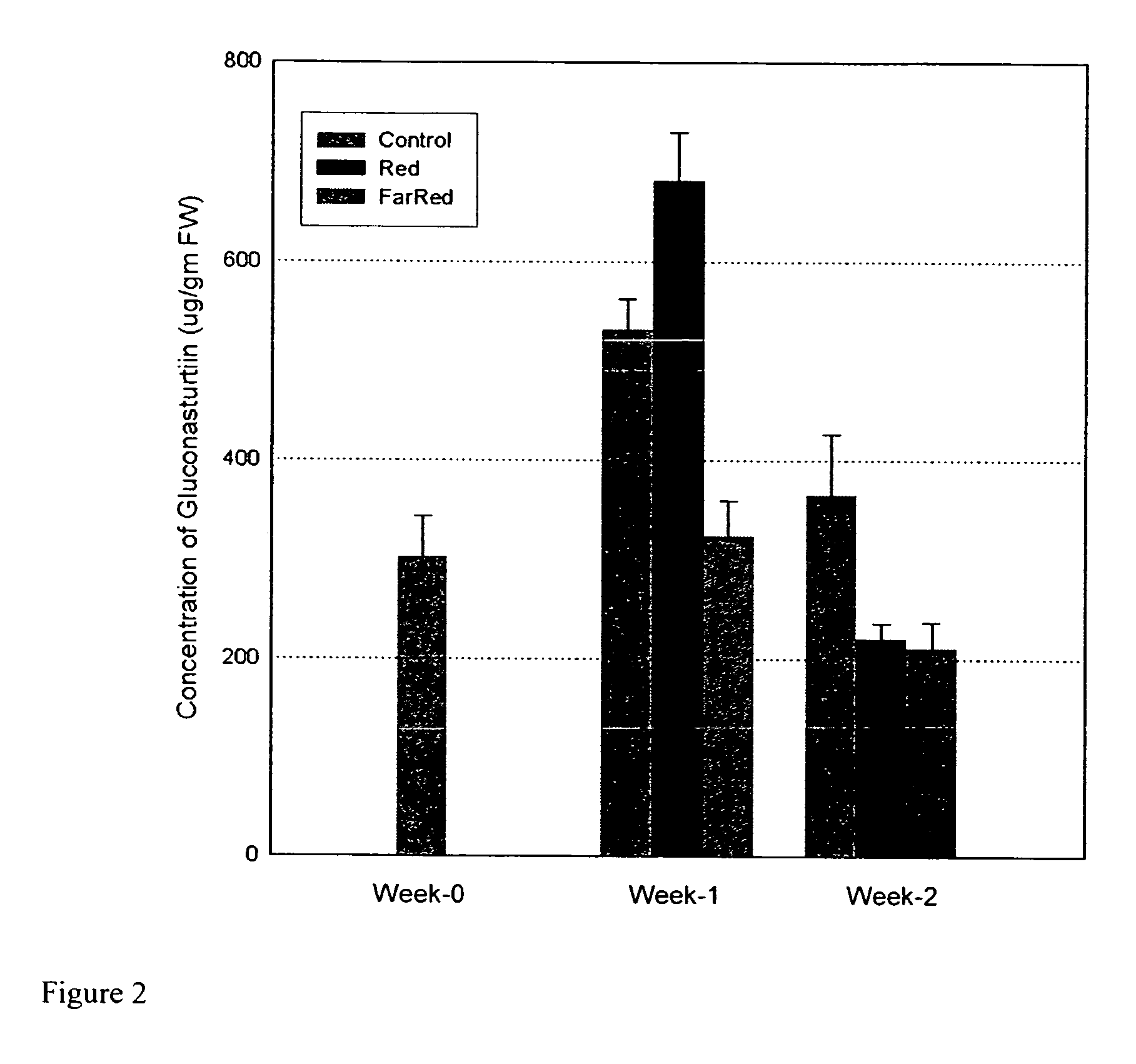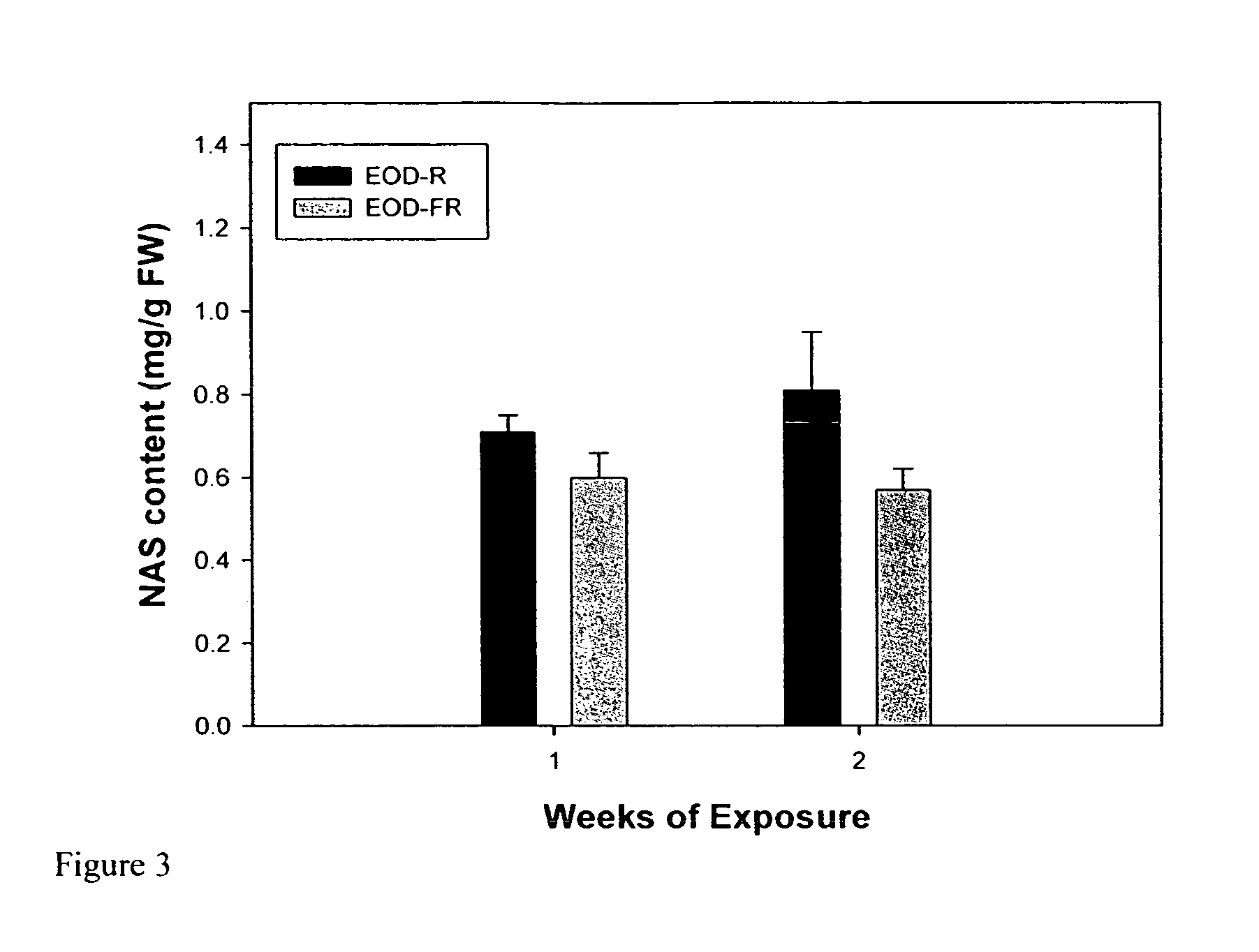Methods for increasing one or more glucosinolates in a plant
a technology of glucosinolate and plant, applied in the field of methods for increasing one or more glucosinolates in plants, can solve the problems of reducing yield by almost 50%, not quantifying the stress level, etc., and achieve the effect of extending the length of the light photoperiod and extending the light photoperiod
- Summary
- Abstract
- Description
- Claims
- Application Information
AI Technical Summary
Benefits of technology
Problems solved by technology
Method used
Image
Examples
example 1
Comparison of Long-Day and Short-Day Treatments
[0037] Watercress (Johnny's Selected Seeds, Albion, Me.) was seeded in 12.5 cm square pots in moist soil-less media (SunGro Horticulture, SunShine SB-300 Universal, Bellevue, Wash.) containing sphagnum peat, bark, perlite, and vermiculite and grown in two EGC growth chambers (Model GCW-15, Environmental Growth Chambers, Chagrin Falls, Ohio). Emerging seedlings were grown at constant 20° C. and under long days (LD, 16 hours light, 8 hours dark). During the light period, the photosynthetically active radiation (PAR) was 450 μmol s−1m−2. PAR was measured with an Apogee Quantum Meter, Model QMSW-SS (Apogee Instruments, Inc., Logan, Utah). Plantlets were thinned to one plant per pot one week after seedling emergence. When plantlets reached the 5th mature leaf stage (approximately 14 day from seeding), 30 plants were exposed to long days (LD) of 16 hours light and 8 hours dark, and 30 plants, in a separate chamber, were exposed to short days...
example 2
Increase in Gluconasturtuin Content by Enhancenient with Low Doses of Red Light
[0042] Watercress plants were grown at 20° C. under LD (16 hours) to the 5th mature leaf stage as described for Example 1. When this stage was reached, the plantlets were moved to different EGC growth chambers: one with MH lamps enriched with far-red (FR) light, and one with MH lamps enriched with red (R) light; total PAR=400 μmol s−1m−2. The R light was provided by three R fluorescent lamps (Sylvania F48T12 / 2364 / HO) filtered through an Encapsulite red tube guard (Lighting Plastics of Minnesota, St. Louis Park, Minn., USA). The FR light was provided by six FR fluorescent lamps (Sylvania F48T12 / 232 / HO) filtered through an Encapsulite FR tube guard (Lighting Plastics of Minnesota, St. Louis Park, Minn., USA). All chambers were adjusted to equal PAR at the level of the plants by altering the distance between the lights and the plants. In the R chamber, the R lamps provided about 2% of the total PAR, and the...
example 3
Increase in Gluconasturtiin Content by an End-of-Day Treatment with Red Light
[0047] Watercress plants were grown at 20° C. under LD (16 hours) to the 5th mature leaf stage as described for Example 1. When this stage was reached, the plantlets were moved to different EGC growth chambers as described for Example 2: one with MH lamps enriched with far-red (FR) light, and one chamber with MH lamps enriched with red (R) light; total PAR=300 μmol s−1m−2. The R light was provided by three R fluorescent lamps (Sylvania F48T1 2 / 2364 / HO) filtered through an Encapsulite red tube guard (Lighting Plastics of Minnesota, St. Louis Park, Minn., USA). The FR light (radiation predominantly in the range from 700-800 nm) was provided by six FR fluorescent lamps (Sylvania F48T12 / 232 / HO) filtered through an Encapsulite FR tube guard (Lighting Plastics of Minnesota, St. Louis Park, Minn., USA). Since FR light is not measured by the quantum sensor used to measure PAR, the FR was measured with a spectrorad...
PUM
 Login to View More
Login to View More Abstract
Description
Claims
Application Information
 Login to View More
Login to View More - R&D
- Intellectual Property
- Life Sciences
- Materials
- Tech Scout
- Unparalleled Data Quality
- Higher Quality Content
- 60% Fewer Hallucinations
Browse by: Latest US Patents, China's latest patents, Technical Efficacy Thesaurus, Application Domain, Technology Topic, Popular Technical Reports.
© 2025 PatSnap. All rights reserved.Legal|Privacy policy|Modern Slavery Act Transparency Statement|Sitemap|About US| Contact US: help@patsnap.com



